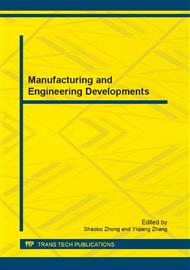[1]
Timothy, L.K., B.E., Bona: An Introduction to Status Space Analysis, Beijing: Higher Education Press, 1985, pp: 209-212.
Google Scholar
[2]
Chen, Shi-min: A General Course of Theoretical Dynamics, Beijing: Higher Education Press, 2007, pp: 172-187.
Google Scholar
[3]
Zhou, Yin-bai: A Textbook for Theoretical Dynamics, Beijing: Higher Education Press, 1985, pp: 210-212.
Google Scholar
[4]
R.C., Dorf, R.H. Bishop,: Modern Control System, Beijing: Scientific Press, 2005, pp: 440-485.
Google Scholar
[5]
The Teaching and Researching Office of Electrics and Mechanics: Engineering Control System, Chen Du: Southwest Jiaotong University Press, 2003, pp: 315-370.
Google Scholar
[6]
He Lian-yun, Meng Jun-huan: To Fulfill the Control over System by Using Status Space Approach, Mechanical Engineering & Automation , 2005 (6), pp: 12-14.
Google Scholar
[7]
Wang Jian-pin, Liu Hong-zhao, Yuan Da-ning, and Su Zhi-xiao: A Study of the Numerical Method of a Nonlinear Vibration through the Status Space Approach, Journal of Vibration Engineering, 2004 (2), pp: 238-243.
Google Scholar
[8]
Hu Zong-wu, and Yan Jun-qi: The Application of the Status Space Approach in Mechanical Vibration, Journal of Vibration and Shock, 1987(3), pp: 41-43.
Google Scholar
[9]
Zhong Wan-xie, et al: The Control Theories of Status Space and Calculation, Beijing: Scientific Press, 2007, pp: 78-94.
Google Scholar
[10]
Huang Zhong-lin: The Calculation and Stimulation and the Control System MATLAB, Beijing: National Defense Industry Press, 2001, pp: 417-457.
Google Scholar


